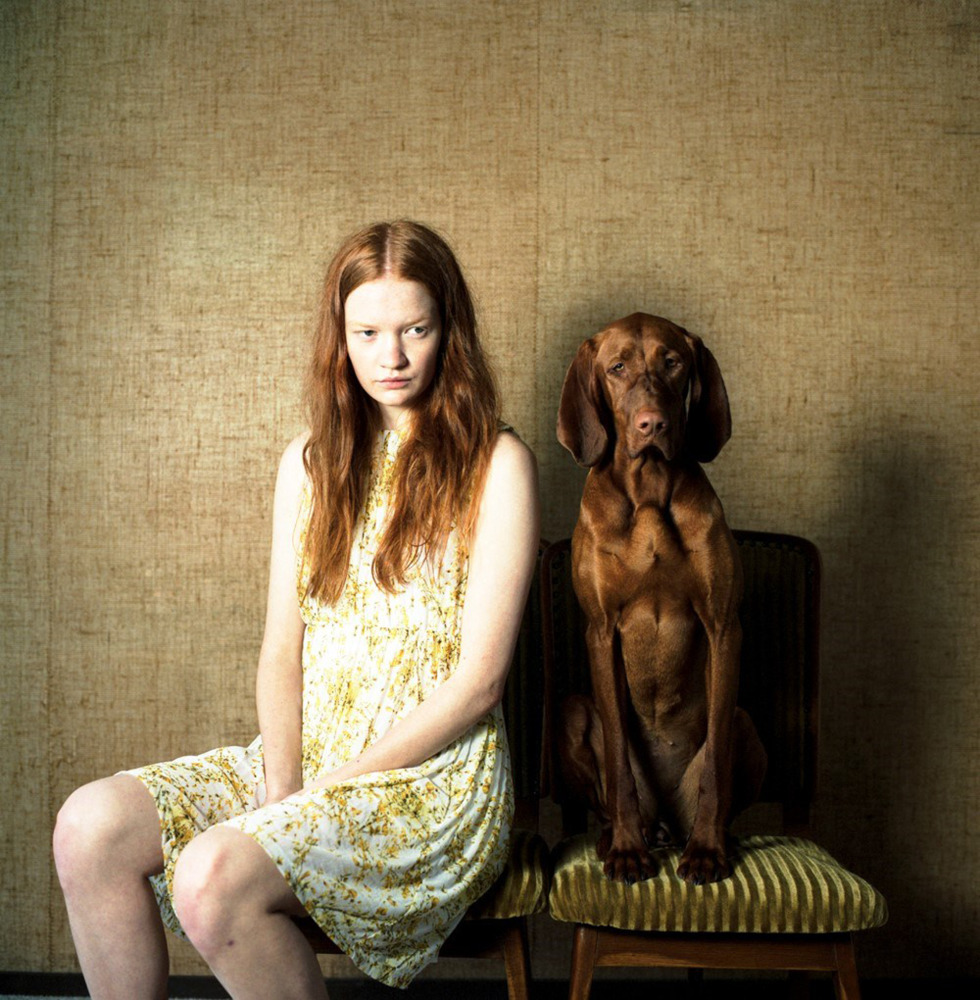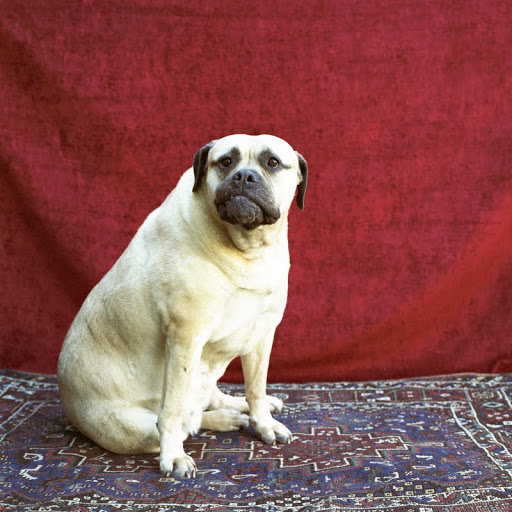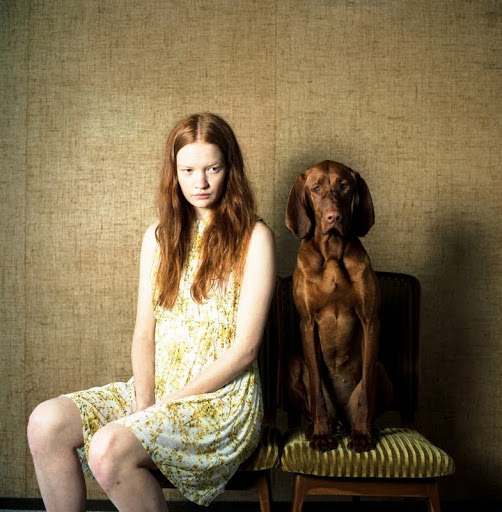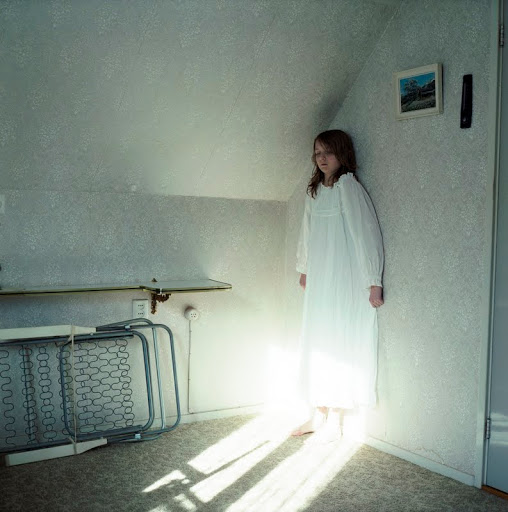“It is important to keep surprising yourself” - interview with Hellen van Meene

Dutch artist Hellen van Meene is well known for her style of photographic portraiture. Van Meene’s works depict mostly adolescents, but there are also sometimes small children or even animals. When looking at these photographs it is hard to say exactly when and where they were made. The background is only available at a glimpse, and the nondescript clothes pull the viewer’s attention completely towards the model. The subject’s postures and facial expressions that van Meen captures can almost paralyze the viewer, so deep is the experience of immersion, as Hellen van Meene stops the moment and captures the viewer within the world of these children.
Dutch artist Hellen van Meene is well known for her style of photographic portraiture. Van Meene’s works depict mostly adolescents, but there are also sometimes small children or even animals. When looking at these photographs it is hard to say exactly when and where they were made. The background is only available at a glimpse, and the nondescript clothes pull the viewer’s attention completely towards the model. The subject’s postures and facial expressions that van Meen captures can almost paralyze the viewer, so deep is the experience of immersion, as Hellen van Meene stops the moment and captures the viewer within the world of these children. Despite their age, many of the subjects bear inscrutable faces that seem to contradict their age, and this adds to the mystery. Apart from children, van Meene likes to feature dogs in her photos. Not surprisingly, she presents these animals with expressions of such concentration, that for a moment one might even doubt their reality, so calmly and quietly do they look into the camera. In all her works, Hellen van Meene proves herself to be a brilliant portraitist, possessing the ability to stop time, to capture the viewer’s attention and make you plunge into the life of another person, someone else who is full of experiences and emotions, visible yet inaccessible behind an impenetrable mask.
This year sees the publication of a book on Helen van Meene’s work. "The years shall run like rabbits”, published by Ludion, covers Hellen’s full body of work from 1995 to 2015. Similarly, The Hague Museum of Photography is hosting an exhibition of works devoted to the same creative period in the life of the photographer. In anticipation of these events, Artdependence Magazine speaks with Hellen about her work and where she stands now, what her challenges and main accomplishments are following her 20 year career.
Artdependence Magazine: You have studied photography, from 1992 to 1996, at the Gerrit Rietveld Academie in Amsterdam. Why did you choose photography as your primary medium?
Hellen van Meene: I always felt very comfortable with a camera. You’ve got quick result, not counting on digital, but when I was still young I used the analogue, so still the developing etc. When you take a photo of a model you can instantly see how the light falls on her face and you can make a portrait in a way that goes way much quicker than a painting. So, the speed of working - this is something that really attracted me. And I just love taking photos of people, it’s just something that felt very natural. I am not a very technical person - I first had a rollerflex and now I have a Hasselblad, and they are both very comfortable to work with. They both feel like my own hands, in a way. They know exactly what I want and the result is always the way I want to have it. I am not a person who is keen on the newest technical cameras and different kind of lenses, I just have my two simple cameras and they do whatever I like and want. And for me that’s sufficient.

© Hellen van Meene, Dogs and Girls.
AD: Your favorite genre is portraiture. Why is this so, and have you also experimented with different genres?
HvM: People keep asking me if portraiture is what I really do. The funny thing is that there are people in my photographs, but they’re not really ‘portraits’. It’s not that I am aiming to make a precise document of the person in front of me. It’s rather more like a translation of someone I see in front of me, and whom I translate into something different. And of course they recognise themselves in the image, but sometimes people can change a lot, especially those who are not very interested in a real life depiction. For me, making a portrait is so much nicer than doing a still life because the person reacts on what I ask, you are working with chemistry and charm, and everything to make the way you like to make your photograph. And I think that this interaction is something I really really like. From the moment you see someone walking in the street and you ask a person to pose for you, to a later moment, in which you may change the clothes, find the right light and right background. All this is part of what makes a photograph, it is a whole interesting process that takes place before the end is really there. And this is what I really like. And if you are keen in making architectural kind of photographs, then you are probably interested in different kind of things. Of course, you probably have to do research on the buildings or whatever you like. I can be very flattering to that building but it doesn’t change anything. But when I am being very positive to someone a lot of things can happen with their personality: she can open up, like a flower that sometimes opens up for me. And this process is so much interesting for me. Even though I did some still life works last year that are included in the book, I will always focus mostly on people, because the interaction is the most fun part of it.

© Hellen van Meene, Dogs and Girls.
AD: How does your working process look like and how do your work with your models? Who are your models and how do you choose them?
HvM: I don’t like standard beauty models; I am more interested in making photos of ordinary people like you and me. For this you need to go out in the street, and that means you go to places where it is very crowded with young people, hang out, and then you just walk around there and use your eyes and see if there is someone who attracts me. I have been doing it for almost twenty years and at a certain moment I just feel that I have done all the faces in the world: I have done red hair, black hair, freckles, big, thin - you name it, I probably have done it. But the funny thing is that every time I see a face that really inspires me there is always something that makes my stomach jump around. It’s a feeling that gives me inspiration: when you see a face and you feel that you really would love to make a photo of her. And these things happen very naturally: it’s when you walk in the street and see a special face - and it is not because of the way she looks like, because of the freckles or the hair - it’s more like a chemistry inside this person that attracts me. These are the things that we do not see but react on them. It’s like when you are standing at a bus stop and you start a small conversation with a woman who is on next to you on the right, but you didn’t strike up a conversation with the person to your left. Why is that? Because she looks nicer, or what? Sometimes you don’t know why. Sometimes it’s a chemistry inside of a person that gives you a feeling of recognition or something else. It’s a combination of ingredients, of a lot of things that make me go and ask someone if I can take their photograph. I always prefer to make an appointment to photograph them, because when you see someone on the street than it can happen that they don’t have the right clothes or they do not have enough time or the background is not enough sufficient or it is just too dark. Then you make an appointment, you can create everything the way you like it. You make an appointment on the right day, when the sun is not too bright or you find your ideal background, and there is a little bit more time. It doesn’t mean that I need two hours to make a photograph but it’s the time you need to prepare yourself. It can only be like 15-20 minutes when you are ready enough. These people are ordinary people, they are not models, so it takes a bit more ‘chatting time’ before you really start. But all this process I really like because in 5 or 10 minutes you already have the feeling: ah, this is what this person is about, and I get this kind of information and all these ingredients are put together in a photograph.

© Hellen van Meene, Untitled.
AD: Do people usually agree to let you photograph them?
HvM: Yes, most of the time they agree. Because when I really have my heart into the subject, because I really feel that this person is worth making a photograph of, especially since I don’t make five hundred photos - there must be something special for me that made my heart jump. And when it happens I am very flattering and charming. And I do mean it. I am so keen to have this person that I know the right things to say to that person not to frighten them or give them any moment to reconsider. It’s like a very interesting game that always happens and 99 percent say yes, lucky for me.
AD: How much do you interfere in the way a person looks?
HvM: Well I love to direct a lot because in my way I am looking for a particular image, which is already in my head, and it is hard to explain to the model. Of course, I ask them not to wear jeans or T-shirts with text and stuff on it because the modern style of clothings brings the photo into a different atmosphere. So I like to use clothes that are timeless, in a way. So sometimes when looking at my photographs people do not have an idea of when I took it: yesterday or ten years ago. In my work it is not about the clothes, but it is a small detail that is very important in it. The same for the hair and everything. Sometimes I like it when the hair is flat and straight and is alongside the face. But sometimes when I am working and I see that it must be totally different and it must be tight up so that the hair is almost gone, like a pony tail at the back that you can’t see. All these details happen when I am working with my subjects. Sometimes you get new ideas while working. When big lines are already setup and small details change the photo to something different it surprises even me, which is why is very important to keep everything open till the last moment. And I always ask my subjects not to wear any make-up, because sometimes make-up can make such a different face, so it is better to have none. Although when I see that the face needs a little bit of lipstick when the color of her lips is a bit too flat, then I will use a little bit of gloss. I like to structure my photo part-by-part until I get the result I am looking for.

© Hellen van Meene, Untitled.
AD: It seems that you do not like to experiment - you have your style and try to work within this style, as if you are not searching for diversity but rather the perfection of your own style. Is this true?
HvM: I like to experiment a lot. When it comes to finding the right conditions for a photograph, then everything is possible. Sometimes you take big steps and sometimes very small ones. The last photograph I made was in December, the photo of the girl that was floating on the sofa. And it was something I never imaged I would like to do, but I was in an old castle in France and I was doing an editorial for a great stylist. She gave me the feedom that I want- it’s always a strict rule when I do an editorial, without following this rule there is no point in asking me. And there was a big brown leather sofa there with a very long back and because of this strange sofa I suddenly got the idea, somewhere in the middle of the night.. I couldn’t sleep, there was a mouse in the room eating my stuff and I was so awake that I just gave my mind a free experiment to do whatever it liked. Then I suddenly realised that I would like to experiment and make this girl floating on the sofa. Then you get everything prepared in your head to get this result. So I made a very big step, but you don’t see it on the photos - it is not Photoshopped, it is the way I experimented. So everything needs to be done on a photograph. I don’t want to go to Photoshop for solutions. You have an idea, you make it. And if it doesn’t work and you think that maybe Photoshop will help to work out, but I never do that, except maybe only if something happened with the original negative. You need to find your own solution and ideas on the site, and that is the most challenging. Sometimes it is a huge step and sometimes it is a small one. When I look at all these photographs that are published in the book, they are all photos from 1994 until 2015, I do see some different things, although they might look like small steps. I also see some big steps. And because my photographs have always been as recognizable as my handwriting, this makes the steps look really small, but for me they are huge. If there would have been no steps, then I would be so bored and could not continue doing the same thing over and over again. And as long as it feels big for me I continue doing it. My motor needs to be going on all the time.

© Hellen van Meene, Untitled.
AD: This year is a very special year for you: you are having a retrospective exhibition at The Hague Museum of Photography, in addition to your book being published: The years shall run like rabbits. The book contains all your body of work from 1995 to 2015, featuring 20 years of your creative work. What do you think are your main accomplishments?
HvM: I keep on surprising myself. Like I said before, if you have a certain subject in front of you for a long time, like working with people, then you can sometimes have the feeling that you have done it all before, captured all the faces in the world. It is not true of course, but in a way you have done them all. You have seen them all. I am not the first person and not the last one to touch this subject. And then, what gives me the energy to still go and do another face, and not to do it the same way I did before. To give my own interpretation of what I see. It is important to keep surprising yourself with your own works. To say: wow, I did something new. Because this is for me the most challenging thing in my work. That’s what keeps me going and I hope it will still do for another 20 years!

© Hellen van Meene, Untitled.
AD: Thank you Hellen and good luck with the exhibition!
More about the exhibition is here.

